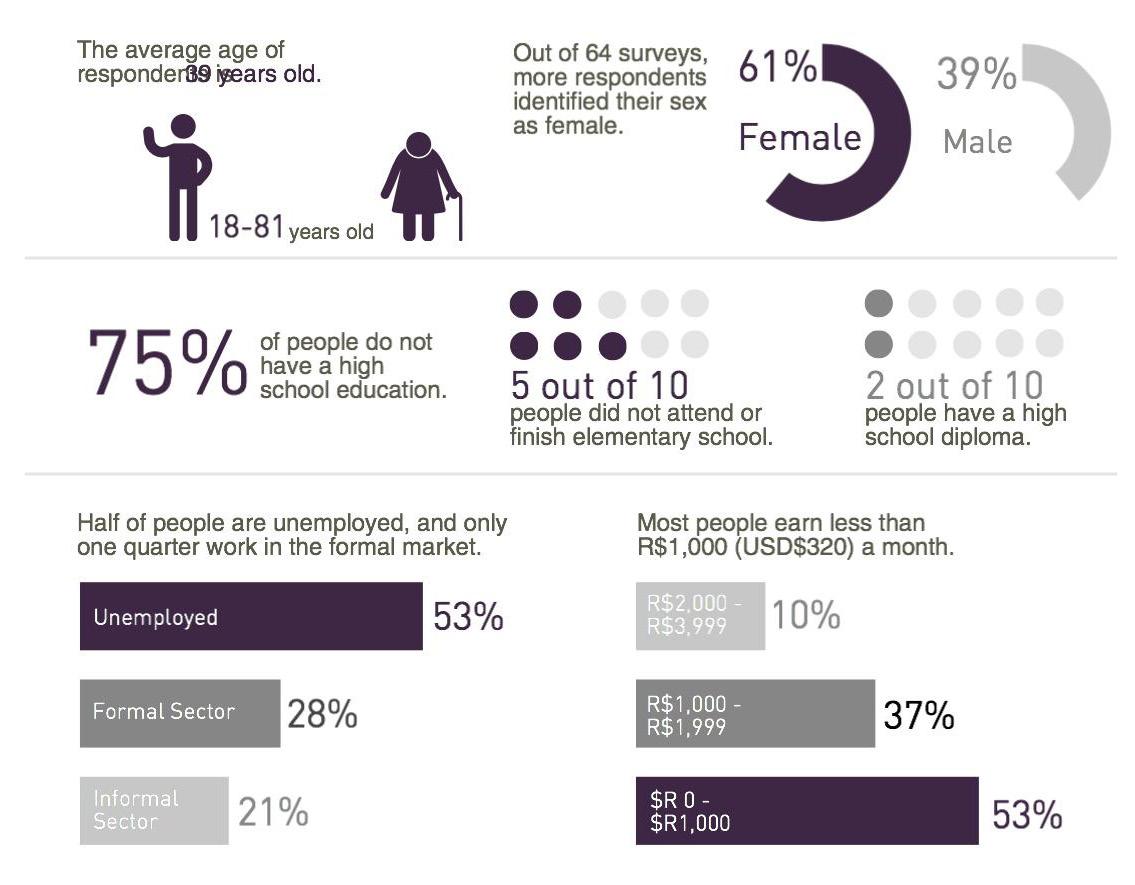
7 minute read
Socio-Demographic Profile
DOOR-TO-DOOR HOUSEHOLD SURVEYS
Door-to-door household surveys provided the Taubman College Team with demographic and housing information of Ocupação Anchieta. Points of interest included education, employment, housing information, household size, family goals and interests, and community involvement. The findings from these surveys help inform housing and policy interventions for the Occupation. Surveys were completed voluntarily with the help of a translator to overcome language barriers.
44 (left) Participants in Door-to-Door Survey Interview.
Conducting surveys was the primary method for gathering data from residents directly. Taubman Team students collected 64 surveys over the course of the three days in Ocupação Anchieta. One student partnered with one of the three to four translators available each day, and the pair traversed a different designated area of the Occupation so that no major sections of the informal settlement would be excluded.
The door-to-door household survey had 25 questions, 22 multiple-choice questions and three openended questions, which were divided in the following four sections: housing conditions, infrastructure, (including water, electricity, waste, and sewage), public life, and socio-demographic questions pertaining to the respondent and the household. The goal of the survey was to better understand household composition and capabilities vis-à-vis their housing and infrastructure conditions. Furthermore, a small subset of questions aimed to elicit residents’ attitudes towards the Occupation and the perceived needs and preferences related to potential infrastructure upgrades and services. Survey questions have been adapted from: the 2015 Taubman College Urban Planning Brazil Capstone, The World Health Organization (WHO), and the United Nations – Human Settlements Programme (UM Taubman Brazil Capstone, 2015; WHO, 2017; UN HABITAT, 2004).
SOCIO-DEMOGRAPHIC PROFILE
Age, Gender and Education
Survey respondents age ranged from 18-81 and 39.4 years old was the average in our pool of respondents. Sixtyone percent of respondents identified as female and 39% as male. The over-representation of female respondents could be explained by the fact that interviews took place during the day and adult men may have
been at work. Alternatively, the Occupation may have a higher level of female-headed households. Given that the door-to-door household survey did not inquire about head of the household by sex, we cannot definitely explain the occurrence. Nonetheless, the literature indicates that in informal settlements, female headed households are a more frequent phenomenon (The World Bank, 2006).
The survey showed that 53% of respondents did not finish an elementary level education and 22% of respondents had less than a fourth-grade education. The United Nations Educational, Scientific and Cultural Organization (UNESCO) defines functional illiteracy as attending school for less than four years (Schiefelbein, 1995). This precarious level of education contrasts with the averages for São Paulo, where 96.4% of the population completed elementary school and 83% completed high school (UNESCO, 2017).
45 Socio-Demographic Profile, Education, Employment and Income Information.
Employment and Income
Fifty-one percent of respondents stated that they are unemployed. Twenty-eight percent of respondents work for formal industries and have a formal contract (meaning an agreement that pays into social security) and the other 21% work for informal sectors. Some common responses for the Occupation include mason, housekeeper, and cook.
The average individual income for all Ocupação Anchieta respondents is about R$488 ($156 USD), much less than the average of the Brazilian minimum wage, which is R$937 ($298 USD), including unemployed respondents (Forte, 2016). Excluding unemployed residents, the average income was around R$844 ($270 USD), which is still below the minimum wage. Only 25% of respondents reported that their income exceeds the minimum wage. This is also
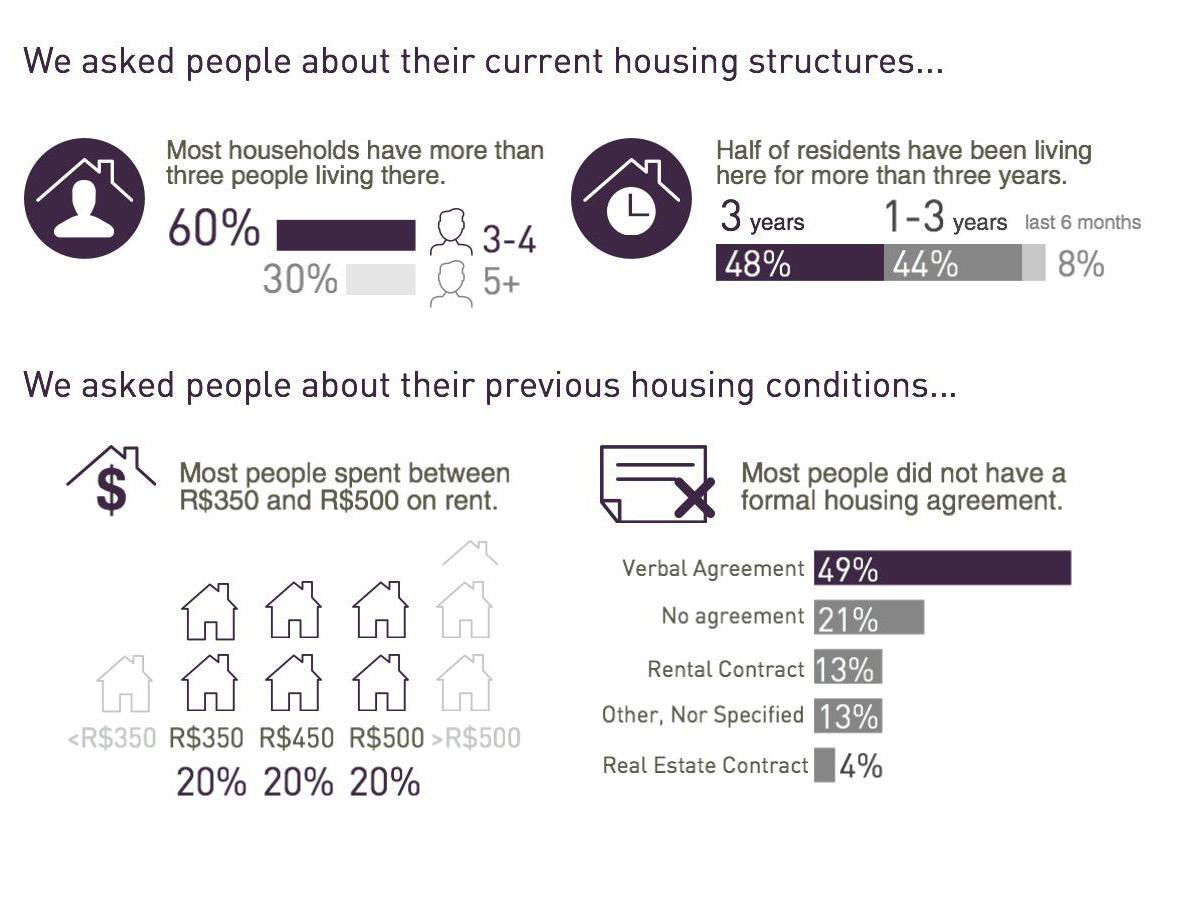
46 Information on Current Housing Structure and Past Housing Conditions.
significantly less than the average individual income in São Paulo metropolitan region, which is R$1,533 ($487) per month (IBGE, 2010).
As for household monthly income, more than half of the respondents (53%) reported earning less than R$1000 ($320 USD) per month. Another 37% had a household income between R$1000 ($320 USD) to R$2000 ($640 USD). In other words, 90% of households earned less than R$2000 ($640 USD) per month. This is much less than the average household income for the São Paulo metropolitan region, which was R$3054 ($976 USD) (IBGE, 2010)
Former Housing Conditions
Considering Ocupação Anchieta is a relatively new occupation, the survey included questions about residents’ former housing conditions before they arrived. Findings show that 45% of respondents rented houses or apartments, while 16% or less rented a room or were allowed to stay with somebody “by favor.” Conversely, only 13% of respondents reported owning their home or apartment before moving to the Occupation. Therefore, renting houses or apartments was the most common housing situation before arriving in Ocupação Anchieta. During survey data collection, several informal conversations took place and survey respondents explained that they had to move to the Occupation because they no longer could afford rent. Some residents had several months of late rent, while others reported that they were not properly feeding their children because rent was too high.
The majority of respondents, about 68%, used to pay R$350 ($112 USD) to R$500 ($160 USD) monthly for their former housing. Considering that more than half of the households earn less than R$1000 ($320
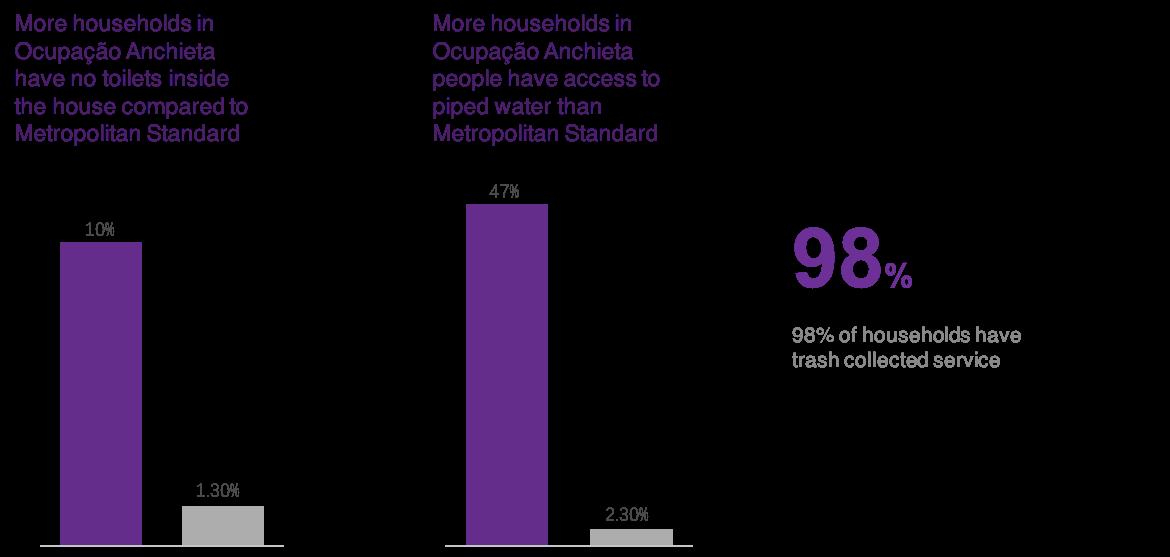
47 Information on Existing Infrastructure in Households.
USD), the rent for their former living situation became a huge burden. Since residents do not pay to occupy the land, this likely explains why respondents choose to settle in Ocupação Anchieta.
The survey also asked residents about the legal status of their former home. As reported, nearly half of the respondents had a verbal rental agreement. Of those surveyed, 21% had no legal documents to prove their rental contract. Furthermore, none of the respondents registered a legal title.
Current Housing Situation and Conditions
About 52% of respondents settled in Ocupação Anchieta within the past three years. The majority, 92% of respondents, came here more than one year ago. These results suggest that more than half of the residents are original dwellers considering Ocupação Anchieta is only four years old. The housing in the Occupation is precarious. Residents typically use simple and vulnerable materials to build their house, such as plywood, metal, tin and other materials that can be found. Informal conversations during the survey administration reveal stories about residents collecting doors, headboards, and toilets from dumpsters and recycling shops. Residents struggle to acquire new construction materials because of their extremely low-income status.
More than Half of Households include Three or Four Persons
Thirty percent of households have three persons living in one home, which is the most common housing scenario. Twenty-seven percent of households have 4 persons in a house, and 11% of residents share a house with more than seven persons.

48 Responses on Most Needed (Popular) Programming for the Occupation.
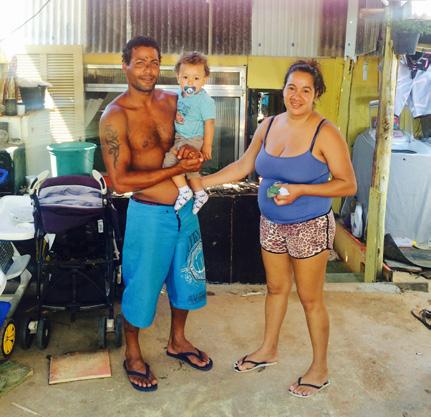
49 Survey Participants.
Majority Families have Less than 3 Bedrooms
About 38% of respondents reported they have only one bedroom, while 56% have two or three bedrooms. In other words, 94% of households have three bedrooms or less. In Brazil, three residents per bedroom is considered the threshold of over-crowdedness (Acolin & Green, 2014). The data suggests that most households in Ocupação Anchieta have more than three members and less than three bedrooms.
Residents have Basic but Rudimentary Services
As an indicator of housing conditions, the Taubman Team chose water supply, access to electricity, private toilet, and trash disposal to evaluate residents’ access to basic services. Only 10% of the respondents do not have a toilet located inside their house. However, this is below the metropolitan standard. In the São Paulo Metropolitan Area, only 1.3% of the households do not have an exclusive-use toilet according to the census (IBGE, 2010). Fortyseven percent of households do not have formal access to piped water, while this is true for only 2.3% of households in the metropolitan area (IBGE, 2010). Fifty-two percent of the respondents stated that although they are connected to the municipal water system, and have access to safe and clean water, this connection is “gato,” or illegally borrowed. Ninety-six percent of respondents reported that their connections to electricity are “gato,” meaning illegally connected to the grid. Therefore, residents in Ocupação Anchieta have some basic services, but they are borrowed from the system and do not have guaranteed access to any basic infrastructure.
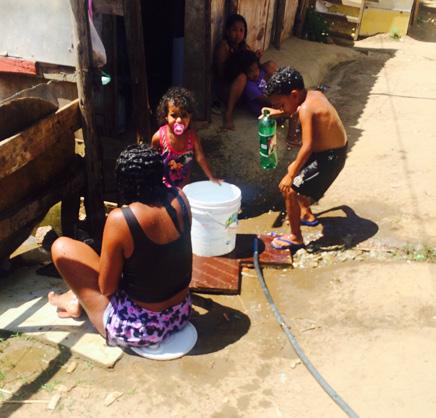
50 Children Play with Water.






